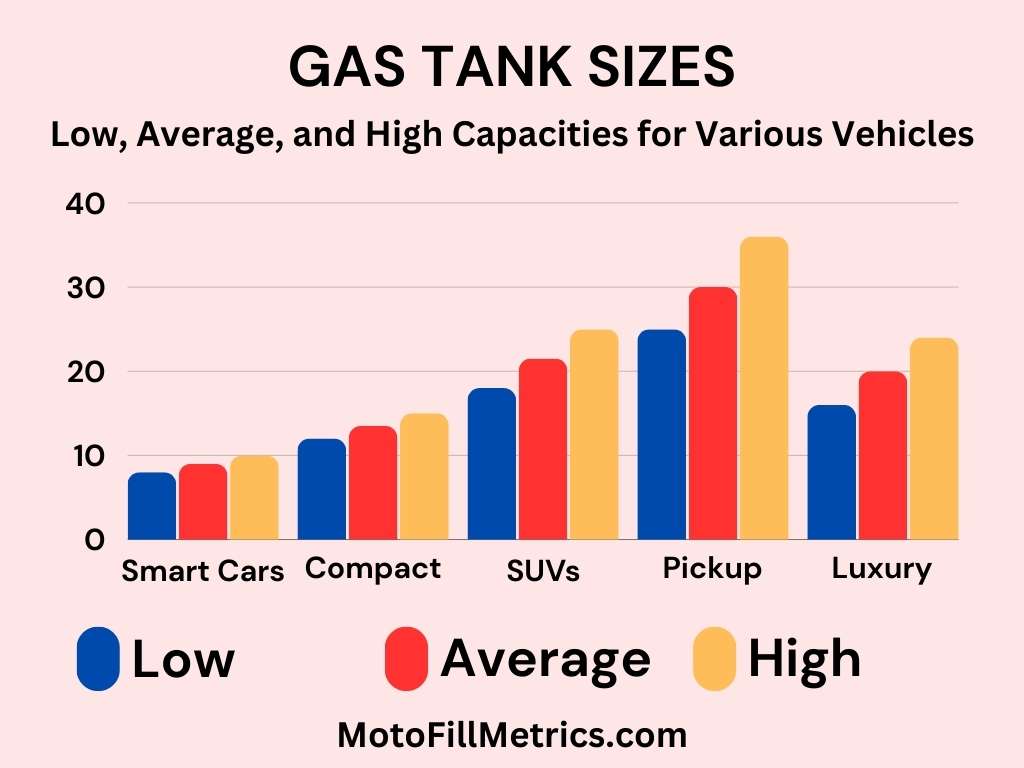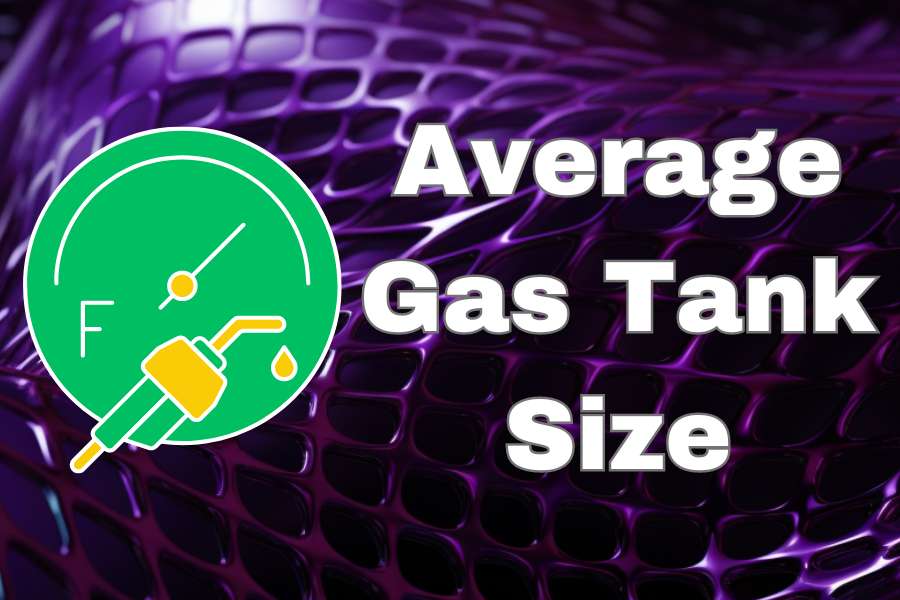
Understanding the average size of a car’s gas tank is an important aspect of vehicle knowledge that can affect a driver’s refueling schedule and travel range.
Typically, compact cars will have smaller gas tank sizes ranging between 12 and 16 gallons. Sedans generally find a middle ground with gasoline tank sizes that usually range from 14 to 18 gallons. Lastly, trucks and SUV have gas tank sizes between 18 to 25 gallons.
That range seems quite substantial…starting at 12 gallons and more than doubling to 25 gallons. Of course, these are averages and there are always outliers. That’s where this and all of the linked articles come in.
Key Takeaways
- Average gas tank sizes for compact cars range from 12 to 16 gallons.
- Larger vehicles, including SUVs and trucks, often have tanks that hold 18 to 25 gallons.
- Knowing your vehicle’s specific fuel tank capacity can aid in planning for travel and fuel consumption.
Average Fuel Tank Capacity
When discussing the average fuel tank capacity of vehicles, it’s important to consider the type of vehicle in question.
We categorize them broadly into three groups: compact cars, sedans and mid-size cars, and larger vehicles like SUVs and trucks.
- Compact Cars: These vehicles typically have a smaller fuel tank capacity in the range of 12-15 gallons. Their efficiency is high, often 30-40 miles per gallon.
- Sedans and Mid-Size Cars: The tanks in these cars are slightly larger, usually averaging around 15.5 gallons. This increase is due to the need for a balance between driving range and vehicle size.
- SUVs and Trucks: Designed with larger tanks to accommodate increased fuel consumption due to towing and hauling capabilities. On average, an SUV’s gas tank size is around 23 gallons, while a truck might hold about 25.4 gallons.
For an in-depth look into vehicle categories and their capacities, the following anchors provide a data-driven context:
- Understand the variances in a compact car’s gas capacity.
- Insight into mid-size and sedan gas capacities.
- Learn specifics about SUV and truck fuel capacities.
Each tank’s capacity ensures that most vehicles can travel a considerable distance. This is typically from 300-400 miles before needing to refuel.
Vehicle Type and Fuel Tank Capacities
Next, we’re going to examine the typical fuel tank sizes associated with various vehicle types.
This knowledge is key for understanding how far a vehicle can travel before needing to refuel and can influence a buyer’s decision based on travel habits and fuel economy.


Compact and Subcompact Cars
Compact and subcompact cars, including hatchbacks, generally have a fuel tank capacity ranging from 12 to 15 gallons.
This size is suitable for these smaller, more fuel-efficient vehicles since they don’t require large amounts of fuel.

Smart Cars
Smart cars, known for their ultra-compact size and their fuel efficiency, typically feature even smaller fuel tanks, around 8 to 10 gallons.
The reduced tank size complements their design which is focused on city driving and frequent, but shorter trips.

Sedans
For sedans, the fuel tank sizes become more varied. The capacity can span from about 14 to 18 gallons for most mid-size sedans.
Larger models or full-size sedans might have tanks on the higher end of this scale to accommodate longer distances between fill-ups.
SUVs and Crossovers

SUVs and crossovers, including full-size SUVs, require larger tanks due to their size and fuel consumption.
These vehicles typically have fuel tanks that hold anywhere from 18 to 25 gallons.
They are designed for versatility and often travel longer distances or carry heavier loads, necessitating fuel storage tanks with a larger fuel supply.

Pickup Trucks
Pickup trucks are built to haul and tow, which increases fuel consumption. It’s common for pickups to have larger tanks to support this type of use.
Pickup trucks can have tanks holding 21 to 36 gallons depending on their size, whether they are light-duty or heavy-duty.

Luxury and Sports Cars
Lastly, luxury and sports cars, such as coupes and high-end sedans, often feature tanks that can hold 16 to 24 gallons.
The larger tanks in sports cars support their powerful engines and high-performance attributes, while luxury cars balance between performance and travel comfort.
Cars with the Biggest Gas Tank Capacity
When selecting a car for long road trips or to minimize fuel stops, we consider the gas tank capacity as a major element.
Large gas tanks provide the convenience of longer driving ranges between refills. Here’s a look at some vehicles boasting substantial gas tank capacities:
| Vehicle Model | Fuel Tank Capacity (gallons) |
|---|---|
| 2022 Audi Q7 | 22.5 |
| 2017 GMC Yukon XL | 31.0 |
| 2018 Cadillac Escalade ESV | 31.0 |
| 2018 Chevrolet Suburban | 31.0 |
| 2023 Subaru Legacy | 18.5 |
| 2022 Dodge Charger | 18.5 |
| 2022 Mercedes-Benz S-Class | 22.1 |
The 2022 Audi Q7 offers a robust 22.5-gallon fuel tank across its engine options, which include a 2.0-liter inline-four cylinder and a 3.0-liter V6 mild hybrid. It’s a blend of luxury and practical long-distance cruising capabilities.

Similarly, large SUVs like the 2017 GMC Yukon XL, 2018 Cadillac Escalade ESV, and 2018 Chevrolet Suburban share the top spot with an impressive 31.0-gallon tank, maximizing their already expansive driving range.
Sporting a 18.5-gallon fuel tank, the 2023 Subaru Legacy is a considerable choice for a car with a large fuel capacity.
Those searching for a combination of performance and fuel tank size might turn to the 2022 Dodge Charger, which also holds 18.5 gallons.
Lastly, the 2022 Mercedes-Benz S-Class boasts a 22.1-gallon tank, reinforcing its status as a high-end vehicle that doesn’t shy away from long journeys.
These vehicles are evidence that various automotive segments – from luxury sedans to full-size SUVs – prioritize offering large gas tanks for extended driving capabilities.
While larger tanks sometimes have fuel costs that reflect the vehicle’s larger size and power demands, they also present an advantage for drivers who value fewer stops at the fuel pump.
Models and Their Tank Sizes
Variations by Brands
Ford vehicles exhibit a range of gas tank sizes. The Ford Expedition, a full-size SUV, is equipped with a hefty fuel tank that can typically hold about 23.3 to 25 gallons.
On the other hand, the Ford F-150, a popular full-size pickup truck, has multiple configurations leading to variations in gas tank sizes, usually between 23 and 36 gallons depending on the model and trim level.

When we turn our attention to Ram, particularly the Ram 1500, we see that it comes with a sizable tank as well, often ranging from 26 to 33 gallons based on the specific model and options chosen.
Chevrolet is not far behind in terms of capacity, with the Chevy Silverado presenting an extensive range as well. Ranging between 24 to 34 gallons, this capacity aligns with the needs of a full-size pickup truck.
Contrastingly, vehicles from Audi, BMW, and Mercedes-Benz, while varying considerably depending on the specific models, generally have smaller tanks, reflecting their luxury sedan and SUV design focus.
Tanks in these cars often range from around 14 to just over 20 gallons.
For Alfa Romeo, the sporty Giulia offers a modest capacity, with a 15.3-gallon tank as standard, befitting its elegant and performance-oriented stature.
The Bentley Bentayga aligns with its luxury status by fitting a sizeable 22.5-gallon fuel tank, which supports its blend of luxury and performance.
Popular Model Comparisons
When we compare the Honda Accord and the Honda Civic, two staples from the Honda lineup, we observe notable differences in their gas tank sizes.
The Honda Accord, a larger sedan, typically features a gas tank of about 14.8 gallons, whereas the smaller and more compact Honda Civic often has a 12.4-gallon tank.
Moving on to the sedans of the luxury segment, the Audi A4, BMW 3 Series, and the Mercedes-Benz C-Class showcase similar range in tank sizes — roughly between 13 and 17 gallons, catering to their blend of performance and luxury needs.
Ultimately, the Nissan Altima, a mid-size sedan, fits into this scale with a standard gas tank size of around 16.2 gallons, aligning it with the expectations for its vehicle class.
By keeping these specifics in mind, we gain a clearer understanding of how different models and brands approach the crucial aspect of fuel storage, which directly impacts range and driving experience.
Do I need a special tool to estimate my fuel tank capacity?
To estimate our vehicle’s fuel tank capacity, we don’t necessarily need a special tool. Modern vehicles often provide this information in the owner’s manual or on a label inside the fuel door.
However, for a more accurate measurement, especially if our vehicle’s documentation doesn’t include this detail, there are online tools available.
Simple steps to estimate fuel tank capacity without special tools include:
- Checking the owner’s manual: This should be our first step as it usually lists the fuel tank capacity.
- Visiting manufacturer’s website: We can look for specifications related to our vehicle’s model and year.
- Observing fuel gauge behavior: Fill up the tank from empty to full and monitor the number of gallons filled. This can get you a close estimate for total capacity.
If these steps don’t provide the information we need, there are online calculators designed to help us estimate our gas tank’s capacity. We only have to input our vehicle’s make, model, and other details if necessary.
Utilizing a Vehicle Identification Number (VIN) is another method for a more detailed approach. Our VIN can be input into various online services that fetch detailed vehicle specs, including the gas tank size.

What information does the VIN reveal about my car’s fuel tank?
We often think of the Vehicle Identification Number (VIN) as a car’s unique fingerprint. This series of numbers and letters encodes detailed information about the vehicle, including aspects related to the fuel tank.
Can I find my car’s gas tank size using the VIN?
Yes, by using the VIN, we can determine the exact specifications of a car, which includes the fuel tank capacity.
Online VIN lookup services provide a straightforward platform where you’re able to enter the VIN and receive a vehicle report.
This report often includes the gas tank size, among other essential vehicle details. Obtaining this information is as simple as entering the VIN into the service and reviewing the report provided.
Frequently Asked Questions
What is the capacity range for the fuel tanks in most cars?
The fuel tanks in most cars typically have a capacity ranging from 12 to 16 gallons. This range is a good balance between vehicle size and travel distance before the need to refuel.
How many liters does an average SUV gas tank hold?
An average SUV gas tank holds approximately 60 to 100 liters, with larger models capable of holding more.
How many gallons does a full gas tank typically contain?
A full gas tank typically contains between 12 to over 30 gallons of gasoline depending on the type of vehicle. Compact cars are at the lower end of this, while large SUVs and trucks are at the higher end.
What constitutes a large gas tank size for a passenger vehicle?
For a passenger vehicle, a large gas tank size usually means anything over 16 gallons. Vehicles with such smaller gas tanks are designed for extended travel ranges or are larger vehicles with higher fuel consumption.





Leave a Reply